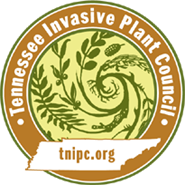Imperata cylindrica (L.) Beauv.
Cogongrass, Japanese Bloodgrass| Threat Level | Category |
|---|---|
| Emerging | Grass |
|
Similar Species May be confused with the following native and/or non-native species. Landscape Alternatives lists native horticultural substitutes |
Saccharum spp. Sorghum halepense Tridens flavus Landscape Alternatives |
|---|

Description
Height
Aggressive, colony-forming dense perennial grass 1 to 5 feet (30 to 150 cm) in height, often leaning in mats when over 3 feet (90 cm) in height.Stem
The stout, upright to ascending stem on cogongrass is not apparent and hidden by overlapping leaf sheaths. Plants arise from branching, sharp-tipped, white-scaly rhizomes.Leaves
Leaves mainly arise from near the base. They are long lanceolate, 1 to 4 feet (30 to 120 cm) long and 0.5 to 1 inch (12 to 25 mm) wide, shorter near the top. Sheaths overlap, with outer sheaths often long hairy and hair tufts near the throat. Most often yellowish green, blades are flat or cupped inward, bases narrow, and the tips sharp and often drooping. The white midvein on the upper surface is slightly-to-mostly off center (varies in an area). Blade margins are translucent and minutely serrated (rough). Ligule is a fringed membrane to 0.04 inch (1.1 mm).Flowers
From February to May (or year-round in Florida), cogongrass produces terminal, silky spikelike panicles, 1 to 8 inches (2.5 to 20 cm) long and 0.2 to 1 inch (0.5 to 2.5 cm) wide, that are cylindrical and tightly branched. Spikelets are paired, each 0.1 to 0.2 inch (3 to 6 mm) long, and obscured by silky to silvery-white hairs to 0.07 inch (1.8 mm).Seeds
Oblong brown grains, 0.04 to 0.05 inch (1 to 1.3 mm) long, ripen May to June and are released within silvery hairy husks for wind dispersal.Images
Photo: Chris Evans, River to River CWMA, Bugwood.orgMore images of Imperata cylindrica
Life History
Cogongrass is a very aggressive, colony-forming dense perennial grass 1 to 5 feet (30 to 150 cm) in height, often leaning in mats when over 3 feet (90 cm) in height. It produces stemless tufts of long leaves, blades yellow green, with off-center midveins and silver-plumed flowers and seeds. Plants arise from branching, sharp-tipped, white-scaly rhizomes. The plant has been sold commercially under the name Japanese Bloodgrass as an ornamental, including the popular red-foliaged cultivar 'Red Baron.' Cogongrass is in the Poaceae or Grass family. To learn more about the struggle with this invasive plant, visit the Cogongrass Web SiteEcology and Habitat
Cogongrass can grow in full sunlight to partial shade, and, thus, can invade a range of sites. Infestations are often in circular with rapidly growing and branching rhizomes forming a dense mat to exclude most other vegetation. It aggressively invades right-of-ways, new forest plantations, open forests, old fields, and pastures, though is absent in areas with frequent tillage. Colonizing by rhizomes and spreading by wind-dispersed seeds, cogongrass is promoted by burning. It is highly flammable and a severe fire hazard, burning extremely hot especially in winter.Origin and Distribution
Cogongrass was initially introduced from Southeast Asia into Florida and southern Louisiana, southern Alabama, and southern Georgia in the early 1900s for soil stabilization. Expectations that the grass would improve forage were unrealized. It is a Federally listed noxious weed.Other states were invasive: FL, GA, VA. Federal or state listed as noxious weed, prohibited, invasive or banned: US, AL, CA, FL, HI, MN, MS, NC, OR, SC, VT.
Source: Information on this plant page is derived primarily from James H. Miller's Nonnative Invasive Plants of Southern Forests, USDA Forest Service.
Management Recommendations
Herbicidal Controls
Foliar Spray Method
Thoroughly wet all leaves with one of the following herbicides in water with a surfactant (September or October with multiple applications to regrowth): Arsenal AC as a 1-percent solution (4 ounces per 3-gallon mix), a glyphosate herbicide as a 2-percent solution (8 ounces per 3-gallon mix), or combination of the two herbicides.Repeat before flowering in spring to suppress seed production and again in successive years for eradication. Older infestations will be more difficult to control.
Nontarget plants may be killed or injured by root uptake.
